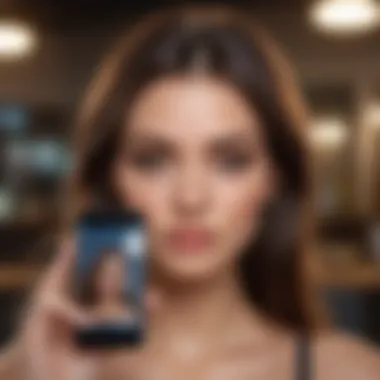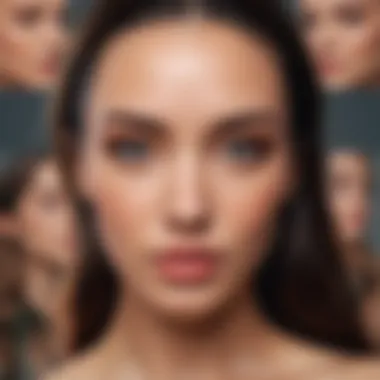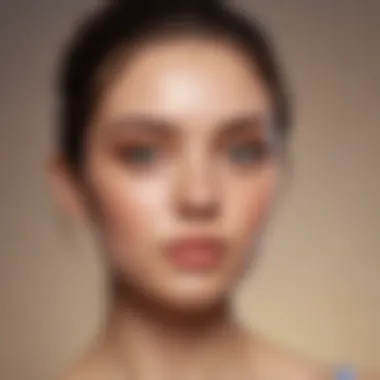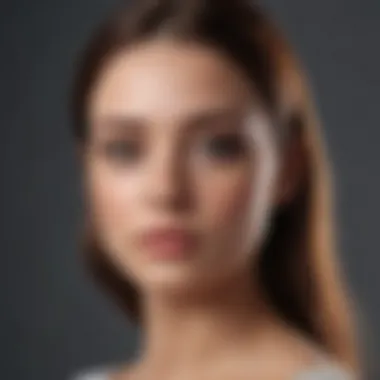The Evolution of Facebook Live Beauty Filters in 2021


Intro
In 2021, beauty filters became an essential feature on Facebook Live. These filters transformed the way users present themselves and interact online. The integration of such filters blends advances in technology with social behavior, altering how we perceive beauty in a digital age. In this article, we explore the various facets of this evolution, from technological innovations to societal implications.
Trending Topics
Current Fashion Trends
Beauty filters in 2021 coincided with various fashion trends. Users often relied on filters to enhance their looks during live broadcasts. This reliance reflects a shift in how individuals approach self-presentation. Filters made it easier to align with current aesthetics within the beauty community. The focus shifted from authentic representation to curated perfection, influencing viewers' expectations further.
Key Points to Consider
- Instant Transformation: Filters allow users to instantly change their appearance, making live content more engaging.
- Access to Professional Tools: Ordinary users now have access to tools that were once exclusive to professionals.
- Influence of Social Media: Live streams are influenced by popular trends, encouraging users to adopt specific styles and looks.
Beauty Innovations
In 2021, ongoing advancements in artificial intelligence (AI) and augmented reality (AR) facilitated the growth of beauty filters. Facebook implemented features that allow real-time adjustments to skin tone, brightness, and other elements. These improvements have been integral in shaping user experiences, enabling a seamless blend of reality and curated images.
"The use of AI in beauty filters has redefined the landscape of self-image and online presence."
Ethical Concerns
With the rise of beauty filters, ethical issues emerged. How do these filters impact users' self-image? Many individuals began to compare their looks against the altered standards set by filters. Concerns arose about body dysmorphia and mental health issues linked to unrealistic beauty ideals portrayed in media.
Discussion continues around the implications for identity in the digital space and how these filters affect genuine self-expression.
The End
Understanding the evolution of beauty filters on Facebook Live in 2021 brings insight into broader societal changes. Users are navigating a landscape filled with possibilities and challenges. The impact of these filters stretches beyond just aesthetics, influencing self-image and social norms. It's crucial to recognize the balance between enhancement and authenticity to foster a healthier digital environment.
Prelude to Facebook Live and Beauty Filters
The topic of Facebook Live and beauty filters captures significant attention in the realms of social media and personal expression. With the explosive growth of Facebook Live streams, millions of users engage in real-time broadcasting, creating dynamic opportunities for communication. These platforms have evolved aesthetically, introducing beauty filters that enhance visual experience. This evolution not only reflects technological advancements but also reshapes how users present themselves online.
Overview of Facebook Live
Facebook Live, launched in 2016, allows users to broadcast video content instantly to their followers. This feature revolutionized content creation by emphasizing immediacy. Viewers can interact through real-time comments, fostering a sense of community. Overall, Facebook Live has grown as a platform for influencers, brands, and everyday users to showcase their lives, ideas, and products. As users increasingly desire to improve their presentation, the incorporation of beauty filters enriches this experience, capturing audience attention.
Definition of Beauty Filters
Beauty filters refer to digital enhancements applied during live broadcasts to modify a user’s appearance. Functions can include smoothing skin, brightening eyes, and adjusting facial structures. These filters allow for a perceived improvement in aesthetics while delivering engaging content. In this context, beauty filters not only serve as tools for self-enhancement but also reflect broader trends in societal beauty standards. As people seek validation online, these filters play a role in shaping perceptions of attractiveness, inviting both enthusiasm and critique in the process.
"With the rise of live streaming, viewers expect polished visuals that meet their standards of beauty. Filters make this possible in a seamless manner."
In subsequent sections, this article will explore technological innovations, cultural implications, critiques, and future trends of beauty filters on Facebook Live.
Technological Innovations Behind Beauty Filters
The landscape of beauty filters on platforms like Facebook Live is shaped significantly by technological advancements. Understanding these innovations offers insights into how they enhance user experience and redefine self-presentation in the digital realm. Key elements include the integration of augmented reality (AR) and artificial intelligence (AI), which serve as the backbone of these filters. These technologies are essential in creating realistic and interactive experiences that engage users and allow for instant modification of appearances in real-time.
AR and AI in Social Media
Augmented reality and artificial intelligence are at the core of beauty filters. AR overlays digital images onto the physical world, allowing users to interact with their environment while applying visual enhancements. This is particularly effective in social media, as it helps create a seamless experience that feels natural to users.
AI plays a crucial role by analyzing user facial features. The technology studies how light interacts with skin and provides corrective suggestions to create a more polished look. For instance, filters can smoothen skin texture, enhance eye brightness, and even adjust facial contours. The speed at which these digital adjustments occur is remarkable. The instant changes engage users, making them feel empowered to present their best selves instantly.


These technologies not only contribute to aesthetic improvements but also enhance engagement. Users tend to spend more time on platforms that allow them to alter their appearance instantaneously. This increase in engagement is vital for content creators and marketers as they aim to attract and retain audiences.
Filter Development Process
The development of beauty filters is a multi-faceted process that combines technical expertise, creative artistry, and user feedback. First, creators begin by identifying the core features of a filter. This may involve determining which enhancements are most desirable among users.
Once the features are established, designers collaborate with developers. They use software like Spark AR by Facebook or Lens Studio by Snap Inc. to create engaging filters. These tools allow them to prototype their ideas quickly and adjust based on preliminary feedback.
Testing is a crucial stage in the filter development process. It often involves focus groups who provide feedback on the effectiveness and appeal of the filter. Based on the insights gained, further adjustments are made. Developers also track how users engage with filters after their release. Metrics such as filter usage rates, sharing statistics, and viewer responses inform future developments, ensuring that filters continue to meet the evolving preferences of users.
"The intersection of technology and beauty is where true innovation lies in social media."
In summary, the fusion of AR and AI reshapes how beauty filters function and are received in social media. The development process is equally important as it ensures these filters resonate with users, maintaining a cycle of innovation and user engagement.
The Popularity Surge of Beauty Filters in
The rise of beauty filters on Facebook Live in 2021 marked a significant shift in how users present themselves online. This surge is not only noteworthy for its immediate impact but also for the long-term implications on digital interactions. As people increasingly engaged with social media, the desire for enhanced personal presentation grew. Beauty filters offered a solution, allowing users to curate their appearance in real-time, thus altering their perceived identity.
Understanding the popularity of beauty filters involves examining the factors influencing user behavior and preferences. Multiple elements contribute to this phenomenon. For one, technological advancements made it easier to access these filters. Quality and variety improved, allowing users to find filters that suited their style and needs. This ease of access fostered a culture of experimentation. Users began to apply beauty filters to explore different looks, enhancing their online personas.
Moreover, beauty filters were not just tools for enhancement; they became a form of self-expression. Users could play with different aesthetics, showcasing creativity while also conforming to social trends. This interactivity significantly contributed to their popularity. As a result, more users joined the platform, eager to engage with this trend, generating a cycle of increasing adoption.
User Demographics and Behavior
User demographics played a crucial role in the popularity of beauty filters in 2021. Various age groups and backgrounds participated in this trend, with a particular emphasis on younger users. According to recent studies, the majority of filter users were in the 18 to 34 age range. This demographic is often characterized by a strong inclination towards social media engagement. The desire to present themselves favorably online drives individuals to utilize beauty filters.
Additionally, certain trends emerged within specific communities. For instance, beauty influencers and content creators leveraged these filters to enhance their live streams, drawing more followers and engagement. This reflection of social validation reinforced the use of filters among their audiences. Recreational users, conversely, often employed beauty filters to feel more confident in their presentations, highlighting a personal need for acceptance.
Engagement Metrics
The engagement metrics associated with beauty filters in 2021 tell a compelling story. Reports indicated a notable increase in live stream viewership on Facebook, with beauty filters contributing significantly to this growth. Users reported spending longer periods in live sessions, as the interactive nature of filters made viewing more enjoyable.
Key engagement statistics include:
- Up to 70% of users reported trying beauty filters during live sessions.
- Live streams featuring beauty filters experienced a 50% increase in viewer retention compared to those without.
- The average interaction rate for sessions with filters was nearly double that of sessions without.
These metrics underline the substantial impact of beauty filters on user engagement and retention. As more users adopted beauty filters, the overall experience on Facebook Live became more dynamic, inviting greater interaction and content sharing.
Cultural Implications of Beauty Filters
The rise of beauty filters on platforms like Facebook Live represents a significant cultural shift in the way society perceives beauty, self-image, and identity. These tools have not only changed how users present themselves but also how they interact with societal standards. The impact is multifaceted, affecting individual self-esteem and broader cultural expectations regarding appearance.
Impact on Beauty Standards
Beauty filters have altered traditional beauty standards, often favoring a specific, sometimes unrealistic ideal. In 2021, the prevalence of these filters led to a normalized expectation of airbrushed perfection. Individuals using these filters often feel pressure to conform to this enhanced version of themselves. The combination of augmented realities and social media networking has led to the emergence of a new concept of beauty standards that prioritizes digitized aesthetics over natural appearances.
"The beauty filter phenomenon blurs the line between reality and beauty, influencing how individuals perceive themselves and others."
Many users, especially young women, begin to question their own appearances when exposed to these curated images. This cultural shift can reinforce narrow definitions of beauty and influence purchasing behaviors, as individuals aspire to fit these ideals. Businesses in the beauty and fashion industry have recognized this trend, crafting marketing strategies around these altered realities to appeal to consumers who want to match the standards seen on social media.
Social Media and Self-Image
The connection between social media and personal self-image has been increasingly scrutinized. Platforms like Facebook Live allow real-time interaction, further complicating the relationship users have with beauty filters. Users often showcase an idealized self, which attracts more engagement and validation through likes and comments. This real-time feedback loop can hyper-focus individuals on the need for aesthetic enhancement through filters.


Studies show that constant exposure to beauty filters can trigger feelings of inadequacy or low self-esteem among users. It creates a cycle where individuals may feel compelled to use these filters to gain approval from their peers. On the other hand, some use these tools to express themselves in ways that align with their unique ideals of beauty.
In summary, beauty filters, while offering tools for self-enhancement, also present challenges by shaping cultural beauty standards and affecting self-image. It is important to continue conversations around their influence to promote a healthy understanding of beauty in the digital age.
Critiques and Ethical Considerations
The rise of beauty filters on Facebook Live has sparked discussions about their implications on both mental health and authenticity. These issues hold significance not only for individuals but also for society as a whole. Understanding these critiques enhances our comprehension of the technology and its role in shaping digital identities.
Mental Health Concerns
The use of beauty filters raises critical questions regarding mental health. Many users, especially women, feel pressure to conform to unrealistic beauty standards presented through these filters. With the continuous exposure to modified images, there are potential risks of body dysmorphia, leading to anxiety and depression. The disparity between users' natural appearance and the filtered version can create a distorted self-image. Consequently, users may become dissatisfied with their appearances, prompting a negative cycle of self-criticism.
Research indicates that heavy users of beauty filters report higher levels of anxiety and social comparison. This compulsion to achieve digitally altered perfection can lead to detriment in interpersonal relationships and overall well-being. Mental health practitioners are observing these trends and emphasizing the importance of promoting realistic beauty perceptions.
Authenticity vs. Altered Reality
The phenomenon of beauty filters also raises the debate of authenticity versus altered reality. Many commentators argue that the filters strip away the genuine representation of an individual, replacing it with a digitally engineered facade. This development fosters a culture where the real becomes undervalued. An individual who engages with beauty filters can create an online personality that deviates significantly from their true self.
On one hand, beauty filters provide individuals with the ability to enhance their features in a controlled environment. On the other hand, frequent reliance on these technologies could blur the line between reality and digital creation. Viewers may struggle to discern authentic content from altered images, contributing to skepticism and confusion in online interactions.
The shift towards filtered realities sparks both creativity and concerns about genuine self-representation.
To confront these complexities, it is essential to foster discussions about the acceptable use of technology while ensuring that the implications are understood by all users. In promoting transparency around these tools, there is a chance to cultivate healthier online experiences, mitigate mental health risks, and ensure that authenticity remains valued in the age of digital beauty.
Case Studies of Influencers Using Facebook Live Filters
The phenomenon of beauty filters within Facebook Live has been significantly influenced by social media influencers. Their capacity to engage audiences and shape trends cannot be overstated. This section examines the case studies of various influencers who have actively used Facebook Live beauty filters to connect with their audiences. Understanding these cases unveils the layers of social interaction, brand partnerships, and the viewer's reception regarding beauty filters.
Influencer Brand Collaborations
Influencers play a pivotal role in the world of beauty filters on Facebook Live, often collaborating with brands to promote their products effectively. These partnerships encompass various aspects. Brands leverage the authenticity and reach of influencers to deliver their messages to a larger audience. Influencers, in response, use beauty filters to enhance their presentation during live broadcasts. This synergy results in a visually appealing experience that resonates with viewers.
For instance, a collaboration between a skincare brand, such as Neutrogena, and an influencer can lead to engaging tutorials featuring specific products. When the influencer uses beauty filters to showcase these products, it not only enhances their features but also creates a polished aesthetic that attracts viewers. The result is a more engaging viewer experience, leading to increased product interest and sales.
The value of these collaborations extends beyond mere promotion. They foster a sense of community among viewers, as they not only consume content but also imagine themselves using those products, thereby influencing buying behavior.
Viewer Response and Trends
The response from viewers to influencers using beauty filters in their Facebook Live experiences is crucial. Viewer engagement metrics illustrate how effective these filters can be in capturing attention. Increased likes, comments, and shares indicate a strong viewer connection.
Many viewers express admiration or curiosity about the filters being used, often discussing their own experiences or preferences in the comments section. This interaction serves as a public forum for discussion and feedback, pushing trends further into the mainstream.
In 2021, trends showed a distinct shift in how beauty filters were perceived. Initially, filters were often criticized for promoting unrealistic beauty standards. However, as influencers began using them more transparently, the perspective changed. This shift indicates that viewers are becoming increasingly comfortable with the idea of enhanced digital appearances. As a result, the popularity of beauty filters continued to grow, setting trends that are likely to persist.
"The authenticity of influencers can bridge the gap between reality and the curated world of beauty filters. This balance often leads to heartfelt connections with viewers, influencing their perception of beauty."
The dynamic between influencers, their collaborations, and viewer reception forms a substantial part of the ongoing conversation about beauty filters in social media. As these trends evolve, they not only shape market strategies but also redefine attitudes toward beauty in digital spaces.
Comparative Analysis: Facebook Live vs. Other Platforms
Understanding the comparative dynamics of Facebook Live beauty filters versus those on other platforms elucidates their distinct roles and relevance in social media. Facebook Live launched beauty filters as a response to the growing demand for enhanced digital communication. These features not only allow users to modify their appearance but also intersect with other social media phenomena, making the analysis imperative.
Instagram Live Filters


Instagram has long been a pioneer in the beauty filter space. It offers a diverse range of options, from subtle enhancements to bold transformations. This platform has a rich ecosystem of creators who actively produce and share filters through Instagram Stories, attracting a vast audience. The filters are designed to be visually appealing and contribute to brand identity.
- User engagement: Instagram promotes user interaction through features like face filters. Users can create personalized content, building community through shared aesthetic experiences.
- Brand collaborations: Many brands collaborate with influencers to develop exclusive filters that align with their marketing strategy. This drives high user engagement and brand loyalty.
- Customization opportunities: Creators can customize filters as per their branding, which adds uniqueness and exclusivity.
In contrast to Facebook Live, Instagram's aesthetic has become synonymous with beauty and aspirational lifestyles. The community-driven nature of Instagram encourages more experimentation with various filters. This approach contrasts with Facebook Live’s focus on real-time broadcast where beauty filters serve to enhance rather than define a user’s presence.
TikTok’s Approach to Beauty Filters
TikTok has emerged as a leading platform for short-form video content, revolutionizing how beauty filters are perceived and utilized. TikTok takes a creative approach, integrating filters directly into editing tools to facilitate engaging content creation.
- Trendy challenges: Many TikTok users leverage beauty filters in trends and challenges. This creates a collective experience and drives users to participate actively.
- Viral potential: The viral nature of TikTok allows beauty filter trends to spread rapidly, influencing user behavior across platforms, including Facebook Live.
- Transformation effects: TikTok offers more playful and dramatic filter options which appeal to a younger audience seeking entertainment over strict enhancement.
Compared to Facebook Live's objective of maintaining authenticity in live broadcasting, TikTok thrives on transformation, often prioritizing creativity and fun over reality. The filters act mostly as tools for storytelling, blending seamlessly into the platform's engaging format.
The competition among platforms shapes how users engage with beauty filters, influencing their digital experiences.
By comparing these three platforms, it is evident that each cultivates unique user interactions and approaches beauty filtration, thereby defining digital identities in multifaceted ways. Facebook Live, with its emphasis on live interaction, contrasts with Instagram's curated visual style and TikTok's playful engagement, revealing the evolution of beauty filters across varied social media landscapes.
Future Trends of Beauty Filters in Social Media
The landscape of beauty filters in social media is in a constant state of evolution. These trends not only influence user experiences but also shape the interactions between brands and consumers. As technology advances, the future trends of beauty filters will likely include enhanced personalization features, deeper integration of artificial intelligence, and a more pronounced focus on mental health considerations. With so many factors at play, understanding these trends is crucial for predicting how beauty standards and self-image may evolve.
Evolving Technology and Features
Technology drives the improvements of beauty filters every year. In 2021, advancements in augmented reality (AR) and artificial intelligence (AI) made it possible for filters to become more sophisticated. New algorithms allow filters to adjust in real time, responding to users' expressions and lighting conditions. This results in a more realistic and immersive experience.
As for features, we can expect further customization options. Users might enjoy the ability to create their unique filters or even collaborate with developers to design specific effects. Community-based filter creation could foster a greater connection between users and the technology, encouraging creativity and self-expression.
In addition to personalization, accessibility will be a key factor. Making beauty filters easier to use for everyone, including those with varying levels of tech-savviness, will likely be a focus. Overall, evolving technology will be about making the experience seamless and engaging.
Predicted User Adoption Trends
User adoption of beauty filters is poised for significant growth. As more individuals join social media platforms, the demand for engaging and visually attractive content will rise. This trend could be particularly pronounced among younger audiences who are constantly looking for ways to express their identities online.
Moreover, different demographics may engage with beauty filters differently. For younger users, particularly those in Gen Z, authenticity blends with enhanced aesthetics. They may embrace filters that enhance features but still retain a sense of realism.
On the other hand, older demographics might adopt beauty filters with a more cautious lens. They may appreciate filters aimed at highlighting natural beauty rather than artificial perfection. As brands recognize these differences, tailored marketing strategies are likely to emerge.
Ending: The Significance of Beauty Filters
Beauty filters have become an integral aspect of social media, capturing the attention of a broad audience, especially on platforms like Facebook Live. Their significance in 2021 cannot be understated. The evolution of these filters has altered not just the landscape of digital beauty but also how users engage with technology and each other. Beauty filters enable users to enhance their appearance, influencing self-perception and social interactions.
Summary of Findings
In this article, we examined various facets of beauty filters on Facebook Live, including:
- The technological advancements that made these filters possible, such as AR and AI technologies.
- The demographic trends and behavioral changes associated with filter usage, revealing that these features appeal to diverse age groups and backgrounds.
- The cultural and ethical implications surrounding their use, highlighting concerns over mental health and authenticity in self-representation.
Furthermore, we explored the case studies of influencers who effectively utilized beauty filters to enhance engagement and brand collaborations. These filters fostered a new dialogue about beauty standards and identity in today's rapidly evolving digital environment.
Final Thoughts on Digital Identity
The rise of beauty filters marks a profound shift in how individuals construct their digital identities. These tools not only affect personal self-image but also shape audience perceptions. For many users, beauty filters serve as a means of self-expression and creativity, allowing them to project idealized versions of themselves.
As technology progresses, the conversation around digital identity will continue to evolve. User engagement shows no signs of slowing down, making it essential for creators and brands to consider the implications of these filters.
"In the digital sphere, how one presents themselves has far-reaching effects beyond mere aesthetics; it becomes a reflection of their identity and aspirations."
Understanding the interplay between beauty filters and self-image offers critical insights into our social interactions. Ultimately, the significance of beauty filters extends beyond the screen, prompting broader discussions about authenticity, perception, and self-worth in an increasingly visual world.



